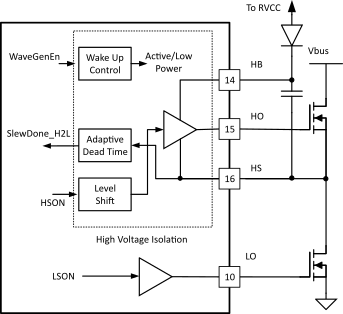SLUAAJ7 June 2022 UCC256402 , UCC256403 , UCC256404
- Abstract
- Trademarks
- 1UCC25640x Selection Guide
- 2UCC25640x Features Brief Overview
- 3UCC25640x Power Up Guidelines and Debugging Notes
- 4References
2.7 Adaptive Dead Time Control
 Figure 2-32 Adaptive Dead Time
Control
Figure 2-32 Adaptive Dead Time
Control- LO turns on when HS detects a slew rate change from high to low (During a switching transition, the slew rate rises up first and then drops back to zero) – indicating HS voltage reaches the minimal value. So, the dead time from HO to LO is automatically adjusted based on HS voltage.
- Minimal detectable slew rate is 0.1 V/ns (check when HS at 20 V).
- Dead time from LO to HO is copied from the previous HO to LO switching.